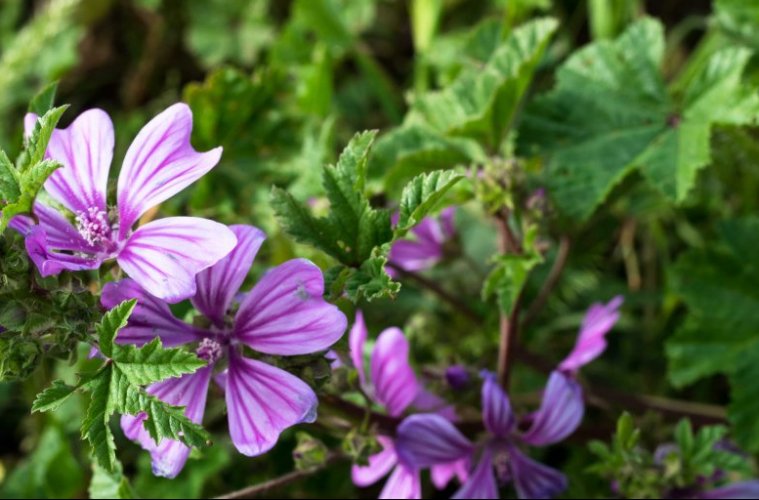Blue mallow has several names such as Mallow, Cheeses, Forest mallow, high mallow, tall mallow, garden mallow, purple mallow, Malva, French Hollyhock, tree mallow, billy buttons, buttonweed, dwarf mallow, cheese mallow, round leaf mallow, dwarf mallow, malice, round dock, round-leaved mallow, and running mallow.
Contents
Habitat
Blue mallow is native to Europe, North Africa, and southwestern Asia. The plant has been naturalized in North America and is cultivated from western Europe to Russia.
It grows in salt marshes, meadows, sides of ditches, banks of tidal rivers, roadsides, abandoned fields, edges of yards, and waste ground.
Description
Mallow is a biennial or perennial plant that grows up to one meter in height. It is coated with small hairs and has creeping stems in general.
The flowers are dark green, and the leaves are pink with deeper purple veins (the flowers of Mauritanian mallow are deep purple).
The width of the flowers is 2 to 5 cm, and the petals are three to four times as long as the cup. The fruit is ring-shaped and divided into various tiny seeds.
Part used
The medicinal part is derived from the leaves, flowers, and roots of the plant.

Traditional Uses and Benefits
Blue mallow has been used as a food source since ancient Greece and Roman times. The plant can be used to treat abscesses, bruises, burns, dermatitis, swellings, and varicose ulcers.
You can use it as a decoction, or you can chew and gargle to treat sore throat as well as throat, mouth, and gingival inflammations.
Respiratory conditions, such as whooping cough and bronchitis, can be treated with a decoction. It can be used as a compress on the stomach to help heal abdominal pains. Mallow can be taken as food to treat constipation or similar GI discomfort.
A gel or poultice made of Blue mallow reduces inflammation and stimulates rapid healing if you experience any insect bites, large bruises, sunburn, or rashes on your skin.
Blue mallow extract can be used for a variety of numbing, insomnia, anxiety, and stress medications and in anesthetics. It makes your nervous system calm and relaxed, and it helps you to feel more productive and energized.
The mallow plant boosts the immune system.
Blue mallow is a perfect remedy if you are suffering from any chest congestion or a respiratory condition.
If you have been injured or wounded, you can apply the leaves of blue mallow to the wounded area in the form of a poultice. Chemicals in the leaves help speed healing, offer certain analgesic properties to the area, and reduce pain and discomfort.
Blue mallow leaves consist of antibacterial and anti-inflammatory components that protect the gums and oral cavity from diseases and infection. Polyphenols present in the plant prevent the development of bacterial plaque by their ability to fight free radicals.
Blue mallow’s polysaccharide mucilages cause relaxation and lubrication of the intestinal walls and better absorption of food. This substance also helps to reduce gastric acidity, which causes stomach discomfort.

Dosage and Precautions
An appropriate range of doses for blue mallow as herbal medicine is not established and probably depends on the user’s age, health, and condition the herb is intended for.
Blue mallow leaves provide good amounts of iron, zinc, and vitamins to pregnant and breastfeeding women.
Related Articles
Health benefits of Chiretta (Andrographis Paniculata)
Health Benefits of Cinquefoil (Potentilla Reptans)
Health Benefits of Clivers (Galium Aparine)
Health benefits of Comfrey (Symphytum Officinale)
DISCLAIMER
The content and information on newerapost for information and educational purposes only. It is not for self-diagnosis and self-treatment. The content is not a medical manual. Before beginning the use of any prescription, medication and pursuing any self-treatment, all readers should consult a physician.
The information given in this article is intended to help you make informed decisions for your health. You must consult with your doctor before pursuing any natural remedies if you are under care for any health condition.
Do not take any vitamins, minerals, herbs, or other supplements without consulting your doctor, if you are taking any medication. The website does not make a representation, express or implied, regarding the accuracy of the information and does not accept any single responsibility for any errors or misuse.

